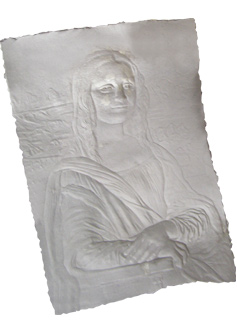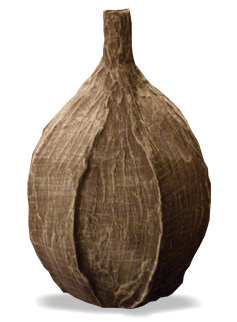Trash to Treasure: “Green” Artists
By Carole Gorney
Waste (also known as rubbish, trash, refuse, garbage, junk) is unwanted or useless material. Or is it?
Americans each generate 4.4 pounds of trash per person a day. That’s a staggering 1,600 pounds times 300 million people per year. The bad news is that only one-third of that tonnage is recycled. The good news is that creative ways to turn waste into useful products are on the increase, and three Lehigh Valley artists are making their own contributions to the effort.
 Sculptress Virginia Abbott epitomizes the old saying that “one man’s—or woman’s—trash is another one’s treasure.” In Abbott’s case, the trash is discarded egg cartons, and the treasure is the incredible masks, tiles and sculptures that she creates from the paper she makes from the carton material. The time-consuming papermaking process includes soaking empty cartons overnight in water, mixing the wet material in a blender, pressing the resulting mush through a strainer, and then compressing the wet pulp into handmade molds.
Sculptress Virginia Abbott epitomizes the old saying that “one man’s—or woman’s—trash is another one’s treasure.” In Abbott’s case, the trash is discarded egg cartons, and the treasure is the incredible masks, tiles and sculptures that she creates from the paper she makes from the carton material. The time-consuming papermaking process includes soaking empty cartons overnight in water, mixing the wet material in a blender, pressing the resulting mush through a strainer, and then compressing the wet pulp into handmade molds.
When the molded pulp dries it has the consistency of paper, and is stronger than the original material, but still amazingly light and capable of maintaining detail. Abbott, who is a resident artist and teacher at ArtsQuest’s Banana Factory, told me she doesn’t have to add anything to the product to make it work so well. “That’s the beauty of it.”
One of Abbott’s largest and most impressive cast paper creations is a detailed concave pressing of Leonardo DaVinci’s Mona Lisa. It was unveiled last October during the DaVinci Science Center’s fifth anniversary celebration. In her work, Abbott has perfected the illusion that Mona Lisa’s eyes are following the onlookers.
There are several things that distinguish Abbott’s work. For one thing, she sculpts and makes her own rubber molds using the lost wax method ( a labor-intensive casting technique dating as far back as 3500 B.C.). Sculpting figures is admittedly her first passion, and she is amazing at reproducing faces and eyes. She is often commissioned to do bronze portrait sculptures, which she said she prefers, but the cost benefits of using recycled paper outweigh those of bronze. “There’s a place for bronze, but a lot more places for paper. I want anyone to be able to come into my studio and buy a piece of art” said Abbott.
If it’s not really bronze, Abbott’s work comes in a close second. She has developed a special patina, a protectant and varnish, that she uses to finish her work. As it dries, it goes through an oxidation process that makes it look just like bronze.
Abbott’s status as a “green” artist extends beyond her use of egg cartons. Her “Ophelia” wall sculpture is studded with discarded items. The frame is an old wooden shutter from a salvage yard. “We generate a lot of garbage,” Abbott said. “Even if you process only one item, it’s amazing how much impact you can have.”

Making a weightier impact is Allentown furniture maker William Kreider, Allentown’s 2008 Visual Artist of the Year. He turns Bethlehem Steel “I” beams into coffee tables, and salvaged materials from Hess’ and other local sources into lamps, mirrors, wine racks and wall shelves.
A history major turned artist, Kreider’s high school graduation gift was a set of tools. In college, he wound up doing repairs on campus. Along the way, he worked with a professional carpenter, and eventually began building sets (among numerous other duties) for the former Pennsylvania Stage Company. While working for the Stage Company, he said he built furniture during his off hours. “Not much—four pieces a year. When the theater closed, I decided to try it full time.” Today, Kreider’s workplace is in the former stage company scene shop.
Kreider started building furniture out of wooden foundry patterns that he discovered while helping tear down Bethlehem Foundry and Machine Company buildings after it closed in 1975. “We were salvaging wood when we found all the wooden gear patterns. We contracted for all of them.” Kreider showed me one of the patterns to admire. “The people who designed and made these had to be absolutely precise,” he said.
When his stock of patterns dwindled, Kreider looked elsewhere for materials. Today, his furniture and accessories are constructed from a variety of discarded “junk.” A flywheel and garage door springs have become the base of a dining room table, a ship’s drive wheel covered in glass serves as a coffee table, and a metal grate is part of a hall table. His next creations are going musical: From a large work table, Kreider picked up a slide trombone and a sousaphone. “I think I’m going to make lamps out of these.”
“I hate to see stuff thrown out. It’s the way I was raised,” Kreider adds, explaining why he uses such unconventional materials for his furniture. According to Kreider, the following saying hung for years on his family’s refrigerator: “The pathologically frugal meet the ecologically correct.”
Despite his eclectic bent, Kreider’s true love is wood. Piles of it in all shapes, sizes and conditions sit in his workshop. He showed me a piece of board rescued from the renovated Allentown School District stadium. The small five-inch piece of Douglas Fir wood had 135 growth rings, according to Kreider, who apparently had counted them. Based on the way lumber is cut from trees, Kreider said he was able to estimate the total age of the tree from which the board was taken. “That tree was growing before Columbus.”
 Self-taught Allentown artist Lee Hughes is taking on another “green” challenge in his own creative way.
Self-taught Allentown artist Lee Hughes is taking on another “green” challenge in his own creative way.
Of the approximately 5.6 billion plastic bottles that are sold each year, only 28 percent are recycled. That doesn’t include the dozens of bottles that have made their way to Hughes’ basement, where he turns them into one-of-a kind art pieces that he markets under “The Christopher Lee Collection” name.
Hughes’ home is both workshop and gallery. Every room showcases handmade creations: from a two-liter plastic bottle turned into an ornamental vase to a sculpture made from several bottles pieced together.
After admiring these and other pieces, it was down to the basement where a huge work table was piled high with works in progress.
To start the process, Hughes cuts heavy white paper into whatever shapes move him at the moment, and then glues the paper shapes to the outside of his bottles. Depending on what he does, the bottle may wind up with different patterns on its outside or it may take on a totally new form. Once the paper is glued in place, it is covered in the same compound used in dry walling. When that dries, Hughes paints his creation with latex house paint. For colors, he said he leans toward earth tones. The entire process takes several weeks from start to finish.
Also a compliance specialist for a petroleum pipeline company in Macungie, Hughes said he started using plastic bottles because they were plentiful and he wanted to use things he already had.
Besides, he added, “I can modify them into any shape I want.” As for the inspiration for the shapes he chooses, “I don’t know where it comes from. If it looks good to me, I use it” said Hughes.
Sources:
Virginia Abbott
www.virginiaabbott.com
William Kreider
www.homeandplanet.com
Lee Hughes
lhughes@buckeye.com




